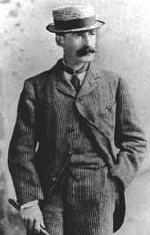
Winslow Homer was a noted American artist during the 1800's. He is remembered for his landscapes, many featuring scenes of the sea, boats, and coastlines.
Homer did not receive formal art training. He began his art career as an apprentice for a commercial lithographer. In the late 1850's he began doing work for Harper's Weekly. His early work for Harper's was primarily to create line art drawings from photographs. At the time pictures were printed by "stamping" them from a large wood block.
To do this, photographs had to first be converted to line art drawings by an artist. In this role, there was little room for artistic interpretation . . . the task was simply to as accurately as possible capture the details of a photograph in a drawing. As such, this work was often published without attribution to Homer. There are several examples of illustrations published which were photographs by Mathew Brady, and then converted to line art by Winslow Homer. As time progressed, Harper's began to expand Homer's role, and he was sent to events to directly create drawings. A notable example was that Homer attended Abraham Lincoln's inauguration, and created several drawings which were published by Harper's. Much of this early work could be described as accurate drawings and illustrations. He was simply capturing the image in front of him as carefully as possible.
Harper's often did not cite Winslow Homer as the artist for pictures that they published. He was sometimes referred to as their "Special Artist". However, this designation was also used for other artists as well. As such, it can be difficult to know which Harper's illustrations were done by Homer, particularly in his early years with the paper.